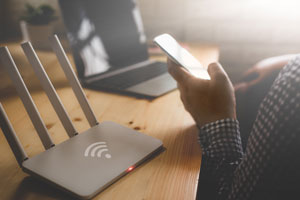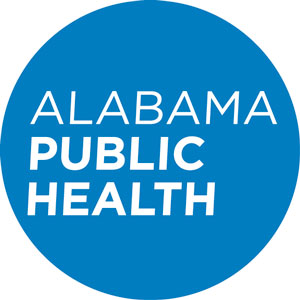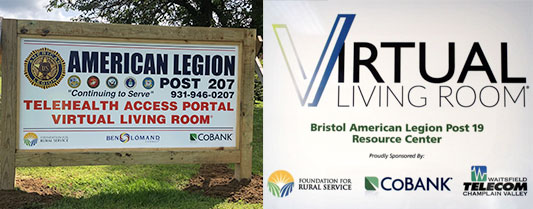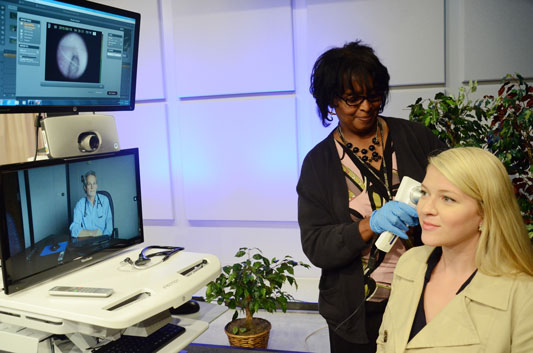Apr 28, 2021
Broadband in Rural America: Faster Speeds for Home and Healthcare
by Allee Mead
 Kelly A.
Hirko, PhD, is an assistant professor of epidemiology and
community-based researcher at Michigan State University
(MSU). She lives and works in rural Traverse City,
Michigan, her hometown. While researching how to help
cancer survivors stay physically active, Hirko learned
that many cancer survivors didn't live close enough to
Traverse City to take advantage of free services at the
cancer center's health and wellness suite.
Kelly A.
Hirko, PhD, is an assistant professor of epidemiology and
community-based researcher at Michigan State University
(MSU). She lives and works in rural Traverse City,
Michigan, her hometown. While researching how to help
cancer survivors stay physically active, Hirko learned
that many cancer survivors didn't live close enough to
Traverse City to take advantage of free services at the
cancer center's health and wellness suite.
Hirko's team looked into a virtual class option, but program coordinators said many of the clients were older and did not have a smart phone or adequate access to broadband in their homes. Hirko reported that about 40% of people in rural Michigan do not have adequate broadband access. "It's really become apparent that a lot of the individuals who are served in our community do not have access to broadband in their homes," she said.

Hirko emphasized that "there is a lot of variation within a rural region," such as differences in broadband access between people who live in Traverse City and people who live outside of town, along with high-income individuals and families versus those with low income. She added, "It is critical to understand this variation in order to ensure that efforts are directed to the specific rural areas in most need."
A 2021 Congressional Research Service report called The Digital Divide: What Is It, Where Is It, and Federal Assistance Programs defines broadband as "high-speed internet access that is faster than traditional dial-up access, always on, and relies on high-speed transmission technologies" such as fiber optic cable or wireless. According to this report, rural and tribal areas fall behind urban and suburban areas in terms of broadband deployment and speed, especially as internet service providers find it expensive to cover a large geographic area with a small number of customers.
Bringing Broadband to Rural America (no longer available online), published in 2020 by the Federal Reserve Bank of Richmond, shows that rural areas benefit from strong broadband infrastructure: "Broadband access and adoption in rural areas is linked to increased job and population growth, higher rates of new business formation and home values, and lower unemployment rates."
As many people have learned during the COVID-19 pandemic, fast, reliable broadband is also important for people to work from home, take online classes, and order groceries and other items online. For healthcare facilities, broadband is needed to send electronic files, support patient portals, and complete telehealth visits.
Hirko added that many populations don't have access to high-quality broadband, so even expanding telehealth services, as has happened during the COVID-19 pandemic, is "going to exacerbate these already existing disparities," since the people who would most benefit from telehealth still can't access it.
In addition, the lack or poor quality of broadband prevents people from accessing a patient portal or other online system to schedule a vaccination appointment: "Many lack broadband access and/or the technological capability to maneuver complicated online scheduling platforms," she said.
For rural communities looking to boost their broadband, funding is often a challenge. As schools closed at the beginning of the pandemic, some communities put Wi-Fi hotspots in parking lots or on school buses. Pam Becker, executive director of the Foundation for Rural Service (FRS), said that these solutions aren't addressing the larger infrastructure issues concerning broadband. She also acknowledged it's not "super easy or cheap, but a lot of it comes down to investing in the infrastructure."
Rural communities across the country are working to improve and leverage their broadband infrastructure and telehealth capabilities, through countywide broadband in a Colorado community; a wide range of telehealth services in Alabama county health departments; and Virtual Living Rooms for veterans in Kentucky, Tennessee, and Vermont.
Countywide Broadband Benefiting Colorado Hospital

Pioneers Medical Center in Meeker, Colorado, was well-equipped to transition employees from working on campus to working at home during the pandemic and helping providers offer telehealth appointments from their homes. Rio Blanco County benefits from having countywide broadband, so the hospital as well as schools and households have reliable internet access.
Internet access in this community has not always been this way. Twenty years ago, Pioneers Medical Center would try to send radiology images over its dial-up connection to Valley View Hospital in Glenwood Springs, which is about 68 miles away. An electronic transfer like this used to take so long that it was often quicker to burn the images onto a CD, drive to Glenwood Springs, and deliver it in person.
Pioneers Medical Center teamed up with Rio Blanco County, the Meeker School District, Meeker municipal IT employees, and the electric cooperative White River Electric Association to put in a fiber ring. While this solution helped the medical center, internet was still expensive.
Pioneers Medical Center became part of the Project THOR Network, a redundant internet network built by the Northwest Colorado Council of Governments and serving 14 communities. The network has multiple fiber lines so that if one is cut, there is no outage because the internet traffic is routed to a different line. Project THOR worked mostly with existing fiber instead of having to build 481 miles of fiber, so project coordinators were able to keep installation costs down.
Bringing Telehealth to County Health Departments
 The Alabama
Department of Public Health (ADPH) knows the importance
of keeping costs down. The previous director of the ADPH
Office of Telehealth, Michael Smith, was interested in
creating a telehealth program in which patients travel to
their county health departments (CHDs) to receive care
from specialty physicians in larger communities. The
program was able to leverage existing broadband
availability in the CHDs, funded through another program.
Smith priced out telehealth carts and decided it would be
cheaper for ADPH to build its own cart for each CHD.
The Alabama
Department of Public Health (ADPH) knows the importance
of keeping costs down. The previous director of the ADPH
Office of Telehealth, Michael Smith, was interested in
creating a telehealth program in which patients travel to
their county health departments (CHDs) to receive care
from specialty physicians in larger communities. The
program was able to leverage existing broadband
availability in the CHDs, funded through another program.
Smith priced out telehealth carts and decided it would be
cheaper for ADPH to build its own cart for each CHD.
These carts have Bluetooth-enabled stethoscopes and handheld examination cameras so that physicians can get a better look at a patient's mole or a lesion, for example. CHD nurses attend the telehealth appointments and check patients' vitals, like blood pressure. Providers from partnering organizations can also send lab kits to the CHD so the CHD nurse can draw a blood sample and send it to the lab.
The ADPH Telehealth Program has 15 partnerships between universities, nonprofit organizations, and other state departments to connect specialty physicians with patients via telehealth. In 2015, a pilot project began with Montgomery AIDS Outreach (now known as Medical Advocacy and Outreach) to reach its patients in five counties. The ADPH Telehealth Program has since expanded, with 65 of Alabama's 67 county health departments having a telehealth cart.
The ADPH Telehealth Program was able to expand as quickly as it did in part because most of the county health departments already had adequate access to broadband. Alabama's WIC program had received federal funds to implement an electronic health record system and had to expand broadband access in order to accommodate the new system. "We were fortunate in Alabama that another program had already done all the legwork," current Office of Telehealth director April L. Golson said.
In 2004, the USDA Food and Nutrition Service created a five-year initiative called the WIC Program State Agency Model (SAM) Project to help state WIC agencies develop model information systems (MIS). As one of the state agencies participating through a multi-state consortium, the Alabama WIC program began building an MIS from the ground up — a process that took many years.
We started realizing that we didn't have the bandwidth to support that in every county. And so that is what led to us upgrading our bandwidth for WIC within public health, which in turn benefited other programs that were needing bandwidth.
Golson, who worked for Alabama's WIC program before her current job in the Office of Telehealth, said that her team had to figure out issues like: "What kind of computers would you need? What software would you need?" she said. "We started developing all that. We started realizing that we didn't have the bandwidth to support that in every county. And so that is what led to us upgrading our bandwidth for WIC within public health, which in turn benefited other programs that were needing bandwidth."
For example, this work with broadband helps improve telehealth programs and helped departments and programs switch to electronic health records (EHRs) instead of paper records. In addition, the improved broadband helps the state clinical laboratory send lab results back to county health departments.
The ADPH Telehealth Program provides ambulatory care as well as educational sessions. A transplant physician at the University of Alabama at Birmingham Hospital teaches a navigation program via teleconferencing. Patients needing a kidney transplant attend this program at their county health department and learn, for example, how to ask for a kidney donor through social media or writing a letter.
ADPH Telehealth Program's original partner, Medical Advocacy and Outreach, focuses on providing testing, PrEP, and other services to patients with, or at risk for, HIV. The University of South Alabama provides ultrasounds at county health departments; the ultrasonographer travels to the CHD, and then the patient meets virtually with a physician. ADPH is currently negotiating a partnership with Tuscaloosa Veterans Affairs to provide behavioral health services to veterans.
Helping Veterans Access Care
Like the ADPH Telehealth Program, Virtual Living Rooms (VLRs) save patients from driving hours to receive care — in this case, to a VA facility. VLRs connect veterans with VA providers via telehealth in locations closer to and more convenient for the veteran. The pilot VLR site opened in the Jackson County Public Library in McKee, Kentucky.

VLRs are funded by the Foundation for Rural Service (FRS), the philanthropic arm of the NTCA—Rural Broadband Association. FRS has a variety of programs that give scholarships and community grants to rural communities, including the VLR program.
Creating a VLR involves four different partners coming together. FRS provides the funding. A location like a library or veterans service organization hosts the VLR site. The NTCA member uses that funding to purchase the equipment and do any needed construction on the planned VLR site and provides the broadband service for that site. The VA provides the telehealth services through its VA Video Connect program.
Becker said veterans can connect to this program from their personal devices, even using a basic telephone to call in, but the program "requires a pretty robust broadband connection" to complete video sessions. VLR sites, then, give all veterans in the community a space with reliable broadband.
In addition to the first VLR site in McKee, Kentucky, FRS has partnered with two more NTCA members to open up VLRs at American Legion posts in Bristol, Vermont, and in Spencer, Tennessee. Becker said a VLR can be set up anywhere, like the library in McKee, "although we're having really good luck putting them in American Legion posts."

Becker said telehealth won't completely replace in-person appointments, "but if this is something that we can handle over the internet, over broadband connection, then that's easier for everybody."
Benefits for Patients and Providers
Golson from ADPH said that broadband is important in helping patients address social determinants of health, like a lack of transportation, that prevent them from receiving healthcare. During a project with the Children's of Alabama hospital seeing pediatric epilepsy patients via telehealth, Golson said, "The money saved and the time saved from work and school was significant." Instead of missing two days of school to see a specialist in person, children and their families only had to travel to their county health department.

For Pioneers Medical Center in Colorado, broadband also makes it easier for patients to access their own medical records, submit prescription requests, and look at test results through a patient portal. In addition, for patients who receive a cancer diagnosis at Pioneers Medical Center but go to another facility for oncology care, Pioneers can transfer images that are high resolution; therefore, the receiving physician does not have to redo the test, which saves the patient from being charged for a duplicate test.
Broadband has also allowed Pioneers Medical Center to bring in equipment like a CT scanner, a wide bore MRI, and a 3D mammography machine. The medical center does not have a radiologist in the building on Fridays, so radiology technicians electronically send tests to the radiologist to read and send back.
Rio Blanco County's broadband has become an important amenity to attract healthcare employees and their families. Pioneers Medical Center's orthopedic clinic, Colorado Advanced Orthopedics, Sports Medicine and Spine, has attracted orthopedic patients from across the country. These patients and their families stay in local hotels and eat at local restaurants, which translates into dollars spent within the community.
Challenges and Lessons Learned
Rural communities and facilities often have to deal with considerable challenges to improve broadband. Golson mentioned that it's hard to convince internet service providers (ISPs) to invest in communities or counties with so few people. Plus, working with multiple ISPs across the state is more time-consuming than working with one company. After the state WIC program was able to improve broadband for CHDs across the state, Golson reported that about seven counties "still probably have lower internet."
Payment structures for telehealth services can also present a challenge. Golson noted that there is no parity legislation in Alabama, so payers do not have to pay for services provided via telehealth. If a payer does reimburse for telehealth, the origination site fee might not be enough to cover the costs of running the program.
If there is a silver lining to the pandemic, it's that it's really brought good attention to telehealth and how it can be a great solution for many, many people.
"If there is a silver lining to the pandemic," Becker said, "it's that it's really brought good attention to telehealth and how it can be a great solution for many, many people."
This pandemic has also shown how important broadband is, Becker said, since it is "affecting your healthcare, it's affecting your education, it's affecting where you work and that you can work from home. I mean, it's affecting where you buy things from."
Resources to Learn More
In February 2021, the Foundation for Rural Service published a white paper called Broadband Today: Rural America's Critical Connection. This paper:
- Defines broadband terms
- Highlights rural broadband stories in areas like healthcare, education, and agriculture
- Explores the COVID-19 pandemic's impact on broadband in rural America
RHIhub lists funding opportunities related to broadband.

